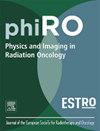Patient-specific deep learning tracking for real-time 2D pancreas localisation in kV-guided radiotherapy
IF 3.3
Q2 ONCOLOGY
引用次数: 0
Abstract
Background and purpose
In pancreatic stereotactic body radiotherapy (SBRT), accurate motion management is crucial for the safe delivery of high doses per fraction. Intra-fraction tracking with magnetic resonance imaging-guidance for gated SBRT has shown potential for improved local control. Visualisation of pancreas (and surrounding organs) remains challenging in intra-fraction kilo-voltage (kV) imaging, requiring implanted fiducials. In this study, we investigate patient-specific deep-learning approaches to track the gross-tumour-volume (GTV), pancreas-head and the whole-pancreas in intra-fraction kV images.
Materials and methods
Conditional-generative-adversarial-networks were trained and tested on data from 25 patients enrolled in an ethics-approved pancreatic SBRT trial for contour prediction on intra-fraction 2D kV images. Labelled digitally-reconstructed-radiographs (DRRs) were generated from contoured planning-computed-tomography (CTs) (CT-DRRs) and cone-beam-CTs (CBCT-DRRs). A population model was trained using CT-DRRs of 19 patients. Two patient-specific model types were created for six additional patients by fine-tuning the population model using CBCT-DRRs (CBCT-models) or CT-DRRs (CT-models) acquired in exhale-breath-hold. Model predictions on unseen triggered-kV images from the corresponding six patients were evaluated against projected-contours using Dice-Similarity-Coefficient (DSC), centroid-error (CE), average Hausdorff-distance (AHD), and Hausdorff-distance at 95th-percentile (HD95).
Results
The mean ± 1SD (standard-deviation) DSCs were 0.86 ± 0.09 (CBCT-models) and 0.78 ± 0.12 (CT-models). For AHD and CE, the CBCT-model predicted contours within 2.0 mm ≥90.3 % of the time, while HD95 was within 5.0 mm ≥90.0 % of the time, and had a prediction time of 29.2 ± 3.7 ms per contour.
Conclusion
The patient-specific CBCT-models outperformed the CT-models and predicted the three contours with 90th-percentile error ≤2.0 mm, indicating the potential for clinical real-time application.
在kv引导放射治疗中,患者特异性深度学习跟踪实时二维胰腺定位
背景和目的在胰腺立体定向放射治疗(SBRT)中,精确的运动管理对于高剂量的安全递送至关重要。用磁共振成像制导对门控SBRT进行分数内跟踪已经显示出改善局部控制的潜力。胰腺(及其周围器官)的显像仍然具有挑战性,需要植入基准。在这项研究中,我们研究了患者特异性的深度学习方法,以跟踪分数内kV图像中的总肿瘤体积(GTV),胰腺头部和整个胰腺。材料和方法条件生成对抗网络在25名患者的数据上进行了训练和测试,这些患者参加了一项经伦理批准的胰腺SBRT试验,用于预测分数内2D kV图像的轮廓。标记的数字重建x线照片(DRRs)由等高线规划计算机断层扫描(ct) (CT-DRRs)和锥束ct (CBCT-DRRs)生成。使用19例患者的CT-DRRs训练群体模型。通过使用在屏气中获得的CBCT-DRRs (CBCT-models)或CT-DRRs (CT-models)对种群模型进行微调,为另外6名患者创建了两种患者特异性模型类型。根据投影轮廓,使用骰子相似系数(DSC)、质心误差(CE)、平均豪斯多夫距离(AHD)和第95个百分点的豪斯多夫距离(HD95)对相应6例患者未见的触发kv图像的模型预测进行评估。结果cbct模型dsc的平均值±1SD为0.86±0.09,ct模型dsc的平均值为0.78±0.12。对于AHD和CE, cbct模型预测2.0 mm以内轮廓的准确率≥90.3%,而HD95模型预测5.0 mm以内轮廓的准确率≥90.0%,每个轮廓的预测时间为29.2±3.7 ms。结论基于患者特异性的cbct模型预测三种轮廓的准确率优于ct模型,90百分位误差≤2.0 mm,具有临床实时应用的潜力。
本文章由计算机程序翻译,如有差异,请以英文原文为准。
求助全文
约1分钟内获得全文
求助全文
来源期刊

Physics and Imaging in Radiation Oncology
Physics and Astronomy-Radiation
CiteScore
5.30
自引率
18.90%
发文量
93
审稿时长
6 weeks
 求助内容:
求助内容: 应助结果提醒方式:
应助结果提醒方式:


